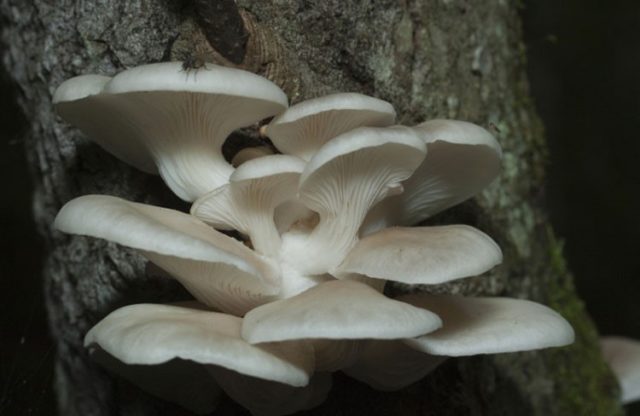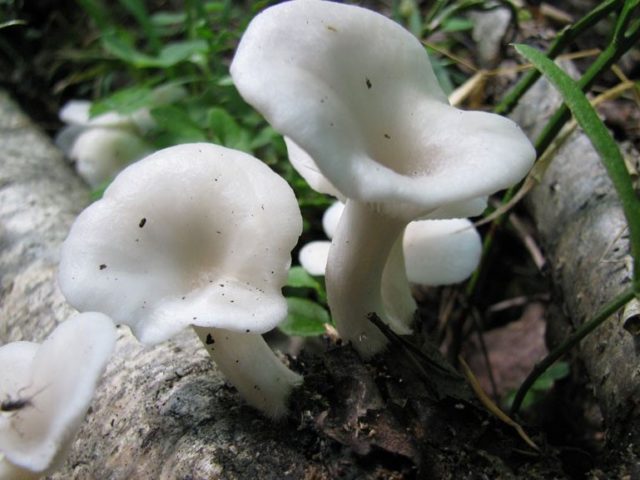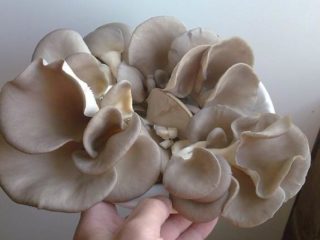Content
- 1 Do oyster mushrooms grow in the forest?
- 2 How oyster mushrooms grow in the forest
- 3 Where do oyster mushrooms grow in nature?
- 4 Where do oyster mushrooms grow in Russia?
- 5 In which forests do oyster mushrooms grow?
- 6 What trees do oyster mushrooms grow on?
- 7 When oyster mushrooms grow
- 8 How long does oyster mushroom grow?
- 9 When to collect oyster mushrooms in the forest
- 10 How to cut oyster mushrooms correctly
- 11 Conclusion
Oyster mushrooms grow on rotting and old trees. They belong to saprophytic fungi. In nature, they are found mainly in forests of the temperate climate zone. Some species prefer warmer regions. They are unpretentious to living conditions, so they are successfully grown artificially.
Do oyster mushrooms grow in the forest?
Oyster mushrooms are cultivated on an industrial scale and are also bred at home. But they also grow in the natural environment. Many mushroom pickers consider wild specimens more tasty and aromatic.
How oyster mushrooms grow in the forest
In the wild you can find several varieties of oyster mushrooms: common (oyster), abundant (horn-shaped), pulmonary (whitish), oak, late (autumn), steppe (royal), orange.
Oyster mushrooms grow in the forest on decaying wood.They can be seen on rotten stumps, in broken trunks, and on fallen trees. They are saprophytes that decompose dead organic matter. These fungi can be called predators: they secrete poisons that enter rotten wood, paralyze the nematodes living in it and obtain nitrogen from these decomposed roundworms, necessary for protein synthesis.

Oyster mushrooms are almost never found alone, more often in large groups
They grow in large groups in several tiers, quite far from the ground. They practically never occur alone. The fruiting bodies grow together, forming bunches weighing up to 3 kg. One bunch contains from 30 fruiting bodies.
One of the most common varieties of oyster mushrooms in Russia is the common or oyster mushroom. It grows only on trees in large groups, consisting of several tiers, resembling peculiar overhanging steps. It can settle on both vertical trees and horizontal ones. In the first case, it is attached to the trunk with short legs, in the second they are longer, attached closer to the edge of the cap.
The late one forms colonies consisting of greenish or olive-colored fruiting bodies. They are located one above the other, fused with legs, forming bundles that resemble a roof.
The abundant one is attached to the bark of old deciduous trees by a long curved stalk that connects to the cap in the very center.

Pulmonary oyster mushroom is called spring or beech
The lung grows together with legs, forming large bundles. It differs from others in its white color and leg with a velvety delicate edge.
Due to its bright color, orange oyster mushroom looks very impressive in the forest; it can survive the winter, but in the spring it becomes more faded. It has practically no legs and is attached to the trunk with a cap.Usually found in small groups, single specimens are rarely seen.
The steppe settles in atypical places: in pastures, deserts, and other open spaces where there are umbrella plants.
Oak forms numerous clumps that grow in several tiers and can completely cover the rotting tree.
The covered one settles on fallen aspens and dead wood. It bears fruit in groups, but in single specimens that do not grow together. Because of this, it received an additional name - single. Attached to the trunk by a sessile dense cap without a stem.

Colony of mushrooms on an old tree
Where do oyster mushrooms grow in nature?
They are distributed throughout the world in the middle zone. Oyster mushroom grows in the forests of Europe, America, and Asia. They are not tied to regions and can appear wherever there are suitable conditions.
Where do oyster mushrooms grow in Russia?
In our country they are found everywhere: in Europe, Siberia, and the Far East. The middle zone, Krasnodar Territory, Primorye, and the Caucasus are especially abundant in them.
In the Moscow region, four varieties of oyster mushrooms grow: common (oyster), carob-shaped (abundant), autumn (late), oak, lemon (ilmak). There are especially many of them in the Kolomna region.
Royal oyster mushroom (eryingi, white steppe mushroom) grows in the southern regions of Russia, in the steppe and desert climate zone.

Royal oyster mushroom is especially valued by mushroom pickers for its good taste.
In the Caucasus, on beech trunks you can find Florida oyster mushroom, native to North America.
Corniculate is common in central Russia, the Caucasus, Primorsky Krai, and Ukraine.
The orange oyster mushroom lives in the temperate climate zone in the Northern Hemisphere.Found in Europe, including Russia, and North America.
Lemon (ilmak) grows in the south of the Far East (in the Primorsky Territory).
Covered is common in the northern and southern regions of Europe.
In which forests do oyster mushrooms grow?
They can be found in forests where there are deciduous trees. They prefer slightly shaded areas. They often settle in ravines and forest edges. They are quite rare in the taiga.

Bright orange mushroom - a real decoration of the forest
What trees do oyster mushrooms grow on?
They prefer deciduous trees - linden, aspen, oak, willow, rowan, birch. Sometimes oyster mushrooms grow on poplars and chestnuts. It is much less common to see this mushroom on conifers.
Mushrooms settle on the organic remains of deciduous shrubs and trees: old or rotting wood, which contains a lot of nitrogen, which is necessary for the nutrition of oyster mushrooms. They absorb lignin and cellulose from the substrate. Suitable for them are dead wood, dead wood, living weak trees, stumps covered with moss, and logging residues.
The common one settles on the trunks and stumps of deciduous trees.
Royal (steppe) grows not only on stumps, but also on dead umbrella plants, such as bluehead, gladysh, ferula.

Oyster mushroom is distinguished by high legs and deep funnels
Carob-shaped is found on deciduous trees, preferring the stumps and trunks of birch, elm, and maple trees. She settles on old oaks and rowan trees. It loves hard-to-reach places: windbreaks, clearings, difficult-to-pass bushes, dead wood, so its colonies are inconspicuous and go unnoticed by mushroom pickers.
Pulmonary prefers old birches, beech trees, aspens, and oaks. Grows on rotting wood, occasionally on living but weak or diseased trees.

Autumn oyster mushroom has a greenish tint and a bitter taste.
The late one grows on deciduous trees, less often on conifers. Loves leftover wood and stumps of such species as maple, poplar, aspen, linden, birch, elm.
The orange one is found infrequently, prefers deciduous and coniferous species, and is found on stumps and fallen trees.
The oak tree settles not only on the remains of oak trees, but also on other trees, for example, elm.
Lemon bears fruit on elms (elms): dead wood, dead or live. It grows in mixed forests, where there are broad-leaved and coniferous trees. In more northern latitudes it can settle on birch trunks.

Ilmakh performs a decorative function, decorating the forest
When oyster mushrooms grow
It is impossible to accurately determine the appearance of fruiting bodies in the forest. This depends on weather conditions, which differ from year to year.
In warm regions of Russia, oyster mushrooms appear from April to November, in more northern regions - from August to September. You need to focus on air temperature and precipitation. Under favorable conditions, it can bear fruit until frost.
For oyster mushrooms to grow, the following conditions are necessary:
- Increased air humidity, which occurs after heavy rains.
- Air temperature from 8 to 17 degrees.
Oyster mushroom, or oyster mushroom, appears at the end of summer and pleases mushroom pickers until late autumn, sometimes until December. Under favorable conditions, you can meet it as early as May.
Pulmonaria and cornaceae are heat-loving species; you need to go for them in the middle of summer, in hot weather, when they are actively growing.The period of abundant fruiting of oyster mushroom is from May to early September; it is afraid of frost and loves moisture, so it bears fruit en masse during the rainy season - at the beginning of summer and towards the end of autumn. The pulmonary grows from May to October.
Steppe, or royal, bears fruit only in the spring months. In the south it appears already in early March.
Autumn grows from September until December, until frost and snow. For fruiting bodies to appear, a rise in temperature of only 5 degrees is sufficient.
The fruiting time of orange oyster mushroom is from early autumn to November. In warmer regions it grows in winter.
Oak can be found from July to September.
Lemon appears in May and bears fruit until October.
The antlers begin to appear in the spring (April), around the same time as the morels/stripes. It grows especially actively in May. The fruiting season ends in July.
How long does oyster mushroom grow?
They grow very quickly, populating the nearest territory. Fruits in waves. The first occurs in May and is the most productive. The next one can be expected in two weeks. Each new wave will be more and more scarce.
When to collect oyster mushrooms in the forest
The season for collecting oyster mushrooms depends on its variety, climate of the area, and weather conditions. In general, they bear fruit from spring to mid-autumn. The traditional time for collecting oyster mushrooms in Russia is September–October. It is at this time that the autumn or late oyster mushroom bears fruit.
The ripeness of the mushroom is indicated by open plates, ready for sporulation; the fruiting body becomes thin and light.

One bunch can weigh up to 3 kg
How to cut oyster mushrooms correctly
They bear fruit in large conglomerates, fused with fruiting bodies. It is recommended to cut them with a sharp knife, being careful not to damage the rhizome.You need to remove everything at once, even if there are small specimens in the bunch: if you leave the small ones, they will die anyway.
You should take mushrooms whose caps do not exceed 10 cm in size: these are most suitable for eating because they have a delicate structure, unlike older specimens.
It is better to leave wet fruit bodies as they will begin to rot very quickly.
Some people advise eating only the caps, and cutting off the hard stems and discarding them. But experienced mushroom pickers believe that they should be used. The fact is that the legs require longer heat treatment. You can make delicious soup, caviar or sauce from them.
Conclusion
Oyster mushrooms grow in large bunches, which is why mushroom pickers love to collect them: in a short time you can fill baskets with a rich harvest. They also have other advantages. There is no need to bend low for them. Among similar mushrooms, there is practically no poisonous one, so oyster mushrooms are considered the safest for beginners.








